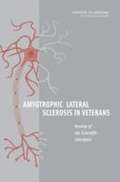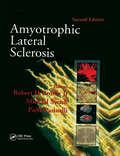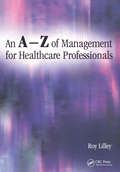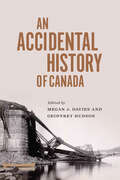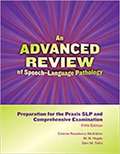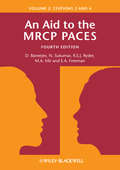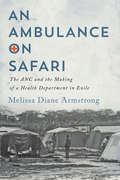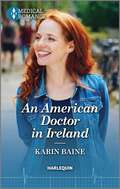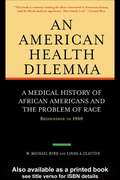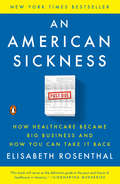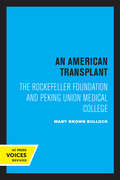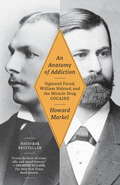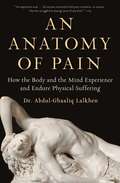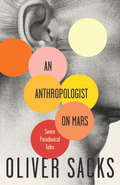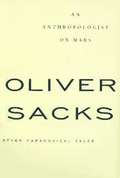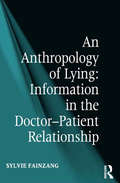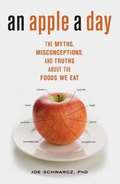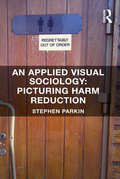- Table View
- List View
Amyotrophic Lateral Sclerosis in Veterans: Review of the Scientific Literature
by Institute of Medicine of the National AcademiesThe National Academies Press (NAP)--publisher for the National Academies--publishes more than 200 books a year offering the most authoritative views, definitive information, and groundbreaking recommendations on a wide range of topics in science, engineering, and health. Our books are unique in that they are authored by the nation's leading experts in every scientific field.
Amyotrophic Lateral Sclerosis, Second Edition
by Michael Swash Robert H Brown Jr Piera PasinelliAmyotrophic lateral sclerosis or motor neurone disease is one of the most debilitating and devastating of the neurological diseases. The only comprehensive textbook available on the topic, this completely reorganized and expanded new edition examines all aspects of ALS from pathology to patient care and provides the reader with a ready reference to help with the difficulties encountered in patient diagnosis and treatment. Undoubtedly an important work in the field, this book will be of great interest to clinical neurologists and trainees, and to all those concerned with the care of people with ALS.
An A-Z of Management for Healthcare Professionals
by Roy LilleyRoy Lilley, creator of the best selling Tool Kit series for the NHS, has produced his personal A-Z of management topics. It covers key issues for today's managers to think about and act upon. The author takes the 26 letters of the alphabet and matches them to practical ideas for managers facing the challenges of change and the pressures of expectations. Each word he has chosen for his 'alphabet' encapsulates and describes a management style or achievement, or perhaps habits or routines, that have impressed him. They are words that describe the extra 'thing' that made a manager stand out, sparkle, seem different from the rest. Each idea is presented with hazard warnings, thinking-issues and exercises, for personal development and organisational improvement. This book is for any manager in healthcare, whether just starting out or a seasoned professional. Clinical directors, general practitioners, practice managers, managers in newly formed Primary Care Trusts and elsewhere in the NHS, and managers in the professions and trades that support and sell to the health service, will all find the book stimulating, informative and practical.
An Accidental History of Canada (McGill-Queen's/AMS Healthcare Studies in the History of Medicine, Health, and Society)
by Megan J. Davies and Geoffrey L. HudsonAlthough Canadian history has no shortage of stories about disasters and accidents, the phenomena of risk, upset, and misfortune have been largely overlooked by historians. Disasters get their due, but not so the smaller-scale accident where fate is more intimate. Yet such events often have a vivid afterlife in the communities where they happen, and the way in which they are explained and remembered has significant social, cultural, and political meaning.An Accidental History of Canada brings together original studies of an intriguing range of accidents stretching from the 1630s to the 1970s. These include workplace, domestic, childhood, and leisure accidents in colonial, Indigenous, rural, and urban settings. Whether arising from colonial power relations, urban dangers, perils in resource extraction, or hazardous recreations, most accidents occur within circumstances of vulnerability, and reveal precarity and inequities not otherwise apparent. Contributors to this volume are alert to the intersections of the settler agenda and the elevation of risk that it brings. Indigenous and settler ways of understanding accidents are juxtaposed, with chapters exploring the links between accidents and the rise of the modern state.An Accidental History of Canada makes plain that whether they are interpreted as an intervention by providence, a miscalculation, an inevitability, or the result of observable risk, accidents – and our responses to them – reveal shared values.
An Advanced Review Of Speech-Language Pathology: Preparation For The Praxis SLP And Comprehensive Examination
by M. N. Hegde Celeste Roseberry-McKibbin Glen M. TellisThe #1 choice for Praxis SLP preparation! Get excellent Praxis SLP preparation with this comprehensive review, study guide, textbook, online practice exams, and reference, all in one! Brand new for 2019, this text extracts the most current, important, and relevant information from the entire field of speech-language pathology and includes it for your review. Simulate the most current Praxis exam experience with the completely revised Online Practice Exams. These interactive, web-based practice tests include questions from three content categories: foundations and professional practice screening, assessment, evaluation, and diagnosis planning, implementation, and evaluation of treatment The included online subscription allows you to take twelve full-length exams and additional short, topic-targeted tests. After completing a test, review your score, total time taken to test, average time per question, total score, number of incorrect answers, and percentage of correct answers. Your correct and incorrect attempt for each topic (e.g., anatomy, voice, etc.) will also be displayed. Additionally, you will receive an analysis of your results, a comparison of your scores over multiple administrations, and a comparison with the scores of test takers from across the country. Get the most out of your study time--take an exam, identify areas that need additional study, review the materials, and repeat the exam. New information includes: Common Core State Standards with links to suggestions for how speech language pathologists can help children with language impairments achieve the standards iPad apps with suggestions for use with persons with communication disorders Pediatric dysphagia Telepractice Appendix of helpful suggestions to prepare for and take the new Praxis examination Experienced professionals will find this text an excellent
An Ageless Woman's Guide to Heart Health
by Elizabeth JacksonHeart disease has long been thought of as a men's issue, when it is actually the leading cause of death in both men and women. In fact, since 1984, more American women than men have died of heart disease. Are you surprised?.Often at the helm of their family's overall health, diet, and nutrition, a woman and her lifestyle decisions can affect not only her own wellbeing; they can determine the habits of her partner and children as well. By becoming better educated, a woman can have a profound, permanent impact on the health of the people around her..An Ageless Woman's Guide to Heart Health is every woman's guidebook to enjoying a heart-healthy life. Renowned cardiologist Dr. Lisa Jackson shares tips and resources to help you make positive steps toward improving your health. Whether you're younger or older, fit or ailing, it's never too late to make changes in your life that can lead you-and those you love-to a healthier heart.
An Ageless Woman's Guide to Heart Health
by Elizabeth JacksonHeart disease has long been thought of as a men's issue, when it is actually the leading cause of death in both men and women. In fact, since 1984, more American women than men have died of heart disease. Are you surprised?.Often at the helm of their family's overall health, diet, and nutrition, a woman and her lifestyle decisions can affect not only her own wellbeing; they can determine the habits of her partner and children as well. By becoming better educated, a woman can have a profound, permanent impact on the health of the people around her..An Ageless Woman's Guide to Heart Health is every woman's guidebook to enjoying a heart-healthy life. Renowned cardiologist Dr. Lisa Jackson shares tips and resources to help you make positive steps toward improving your health. Whether you're younger or older, fit or ailing, it's never too late to make changes in your life that can lead you-and those you love-to a healthier heart.
An Aid to the MRCP PACES
by Robert E. Ryder M. Afzal Mir Edward Fogden Anne FreemanAn Aid to the MRCP PACES Volume 3: Station 5 is a brand new, fully updated edition of the best-selling PACES revision guide to address the newest Station, covering Integrated Clinical Assessment, with content guided by the experiences of PACES candidates.The cases and scenarios have been written in accordance with the latest examining and marking schemes used for the exam providing an invaluable training and revision aid for all MRCP PACES candidates.In order to fully support candidates taking the exam, this trilogy of best-selling revision aids is now presented as:An Aid to the MRCP PACES Volume 1: Stations 1 and 3, Fourth Edition9780470655092An Aid to the MRCP PACES Volume 2: Stations 2 and 4, Fourth Edition9780470655184An Aid to the MRCP PACES Volume 3: Station 5, Fourth Edition9781118348055
An Aid to the MRCP PACES
by Robert E. Ryder E. Anne Freeman M. Afzal Mir N. Sukumar Dev BanerjeeThis new edition of An Aid to the MRCP Paces Volume 2: Stations 2 and 4 has been fully revised and updated, and reflects feedback from PACES candidates as to which cases frequently appear in each station.The cases and scenarios have been written in accordance with the latest examining and marking schemes used for the exam providing an invaluable training and revision aid for all MRCP PACES candidates.
An Aid to the MRCP PACES
by Robert E. Ryder E. Anne Freeman M. Afzal MirThis new edition of An Aid to the MRCP Paces Volume 1: Stations 1 and 3 has been fully revised and updated, and reflects feedback from PACES candidates as to which cases frequently appear in each station.The hundreds of cases have been written in accordance with the latest examining and marking schemes used for the exam and, together with exam hints, tips, routines and clinical checklists, provide an invaluable training and revision aid for all MRCP PACES candidates.
An Alphabet of Good Health in a Sick World
by Mary Budinger Martha M. GroutWant to feel better? Been to a dozen doctors and still have no answer? Look no further. Discover why illness is really your friend. Realize that illness is your body's cry for help, your best effort at telling yourself that something is very wrong. Looking at your body as the enemy and treating it with brute force is the conventional way to treat. But, if you are open to it, there is another way. Healthy food and healthy environments beget health for the body, no matter what the genetics suggest. We call this paradigm "Green Medicine". Treat the whole body, not just the part that is currently screaming. And recognize that illness occurs for reasons that may have global implications.
An Ambulance on Safari: The ANC and the Making of a Health Department in Exile (McGill-Queen's/Associated Medical Services Studies in the History of Medicine, Health, and Society #53)
by Melissa Diane ArmstrongDuring the apartheid era, thousands of South African political activists, militants, and refugees fled arrest by crossing into neighbouring southern African countries. Although they had escaped political oppression, many required medical attention during their period of exile. An Ambulance on Safari describes the efforts of the African National Congress (ANC) to deliver emergency healthcare to South African exiles and, in the same stroke, to establish political legitimacy and foster anti-apartheid sentiment on an international stage. Banned in South Africa from 1960 to 1990, the ANC continued its operations underground in anticipation of eventual political victory, styling itself as a "government in waiting." In 1977 it created its own Health Department, which it presented as an alternative medical service and the nucleus of a post-apartheid healthcare system. By publicizing its own democratic policies as well as the racist practices of healthcare delivery in South Africa, the Health Department won international attention for its cause and provoked widespread condemnation of the apartheid state. While the global campaign was unfolding successfully, the department's provision of healthcare on the ground was intermittent as patients confronted a fledgling medical system experiencing various growing pains. Still, the legacy of the department would be long, as many medical professionals who joined the post-apartheid Department of Health in South Africa had been trained in exile during the liberation struggle. With careful attention to both the international publicity campaign and on-the-ground medical efforts, An Ambulance on Safari reveals the intricate and significant political role of the ANC's Health Department and its influence on the anti-apartheid movement.
An American Doctor in Ireland: Celebrate St. Patrick’s Day with an irresistible Irish surgeon in this captivating Medical Romance!
by Karin BaineThe gorgeous single dad she encountered at the St. Patrick&’s Day parade…is her new colleague! Will working together be too much temptation for these doctors? Read on in Karin Baine&’s latest Medical Romance! CAN A FLING LEAD TO FOREVER? American doctor Mae Watters arrives in Dublin, determined to escape her recent heartbreak. This move is about finding a new life, and the last thing on her mind is romance! So why can&’t she resist the man she meets at the St. Patrick&’s Day parade, her sexy colleague, Dr. Liam O&’Conner? He&’s a single dad with baggage of his own! Will a passionate fling give them the confidence to move forward—together?From Harlequin Medical: Life and love in the world of modern medicine.
An American Health Dilemma: A Medical History of African Americans and the Problem of Race: Beginnings to 1900
by W. Michael Byrd Linda A. ClaytonAt times mirroring and at times shockingly disparate to the rise of traditional white American medicine, the history of African-American health care is a story of traditional healers; root doctors; granny midwives; underappreciated and overworked African-American physicians; scrupulous and unscrupulous white doctors and scientists; governmental support and neglect; epidemics; and poverty. Virtually every part of this story revolves around race. More than 50 years after the publication of An American Dilemma, Gunnar Myrdal's 1944 classic about race relations in the USA, An American Health Dilemma presents a comprehensive and groundbreaking history and social analysis of race, race relations and the African-American medical and public health experience. Beginning with the origins of western medicine and science in Egypt, Greece and Rome the authors explore the relationship between race, medicine, and health care from the precursors of American science and medicine through the days of the slave trade with the harrowing middle passage and equally deadly breaking-in period through the Civil War and the gains of reconstruction and the reversals caused by Jim Crow laws. It offers an extensive examination of the history of intellectual and scientific racism that evolved to give sanction to the mistreatment, medical abuse, and neglect of African Americans and other non-white people. Also included are biographical portraits of black medical pioneers like James McCune Smith, the first African American to earn a degree from a European university, and anecdotal vignettes,like the tragic story of "the Hottentot Venus", which illustrate larger themes.An American Health Dilemma promises to become an irreplaceable and essential look at African-American and medical history and will provide an invaluable baseline for future exploration of race and racism in the American health system.
An American Sickness: How Healthcare Became Big Business and How You Can Take It Back
by Elisabeth Rosenthal<P>At a moment of drastic political upheaval, a shocking investigation into the dangerous, expensive, and dysfunctional American healthcare system, as well as solutions to its myriad of problems In these troubled times, perhaps no institution has unraveled more quickly and more completely than American medicine. <P>In only a few decades, the medical system has been overrun by organizations seeking to exploit for profit the trust that vulnerable and sick Americans place in their healthcare. Our politicians have proven themselves either unwilling or incapable of reining in the increasingly outrageous costs faced by patients, and market-based solutions only seem to funnel larger and larger sums of our money into the hands of corporations. Impossibly high insurance premiums and inexplicably large bills have become facts of life; fatalism has set in. Very quickly Americans have been made to accept paying more for less. How did things get so bad so fast? <P> Breaking down this monolithic business into the individual industries—the hospitals, doctors, insurance companies, and drug manufacturers—that together constitute our healthcare system, Rosenthal exposes the recent evolution of American medicine as never before. How did healthcare, the caring endeavor, become healthcare, the highly profitable industry? <P>Hospital systems, which are managed by business executives, behave like predatory lenders, hounding patients and seizing their homes. Research charities are in bed with big pharmaceutical companies, which surreptitiously profit from the donations made by working people. Patients receive bills in code, from entrepreneurial doctors they never even saw. The system is in tatters, but we can fight back. Dr. Elisabeth Rosenthal doesn't just explain the symptoms, she diagnoses and treats the disease itself. <P>In clear and practical terms, she spells out exactly how to decode medical doublespeak, avoid the pitfalls of the pharmaceuticals racket, and get the care you and your family deserve. She takes you inside the doctor-patient relationship and to hospital C-suites, explaining step-by-step the workings of a system badly lacking transparency. <P>This is about what we can do, as individual patients, both to navigate the maze that is American healthcare and also to demand far-reaching reform. An American Sickness is the frontline defense against a healthcare system that no longer has our well-being at heart. <P><b>A New York Times Bestseller</b>
An American Transplant: The Rockefeller Foundation and Peking Union Medical College
by Mary B. BullockThis title is part of UC Press's Voices Revived program, which commemorates University of California Press’s mission to seek out and cultivate the brightest minds and give them voice, reach, and impact. Drawing on a backlist dating to 1893, Voices Revived makes high-quality, peer-reviewed scholarship accessible once again using print-on-demand technology. This title was originally published in 1980.
An Anatomy of Addiction: Sigmund Freud, William Halsted, and the Miracle Drug Cocaine
by Howard MarkelFrom acclaimed medical historian Howard Markel, author of When Germs Travel, the astonishing account of the years-long cocaine use of Sigmund Freud, young, ambitious neurologist, and William Halsted, the equally young, pathfinding surgeon. Markel writes of the physical and emotional damage caused by the then-heralded wonder drug, and how each man ultimately changed the world in spite of it--or because of it. One became the father of psychoanalysis; the other, of modern surgery. Both men were practicing medicine at the same time in the 1880s: Freud at the Vienna General Hospital, Halsted at New York's Bellevue Hospital. Markel writes that Freud began to experiment with cocaine as a way of studying its therapeutic uses--as an antidote for the overprescribed morphine, which had made addicts of so many, and as a treatment for depression. Halsted, an acclaimed surgeon even then, was curious about cocaine's effectiveness as an anesthetic and injected the drug into his arm to prove his theory. Neither Freud nor Halsted, nor their colleagues, had any idea of the drug's potential to dominate and endanger their lives. Addiction as a bona fide medical diagnosis didn't even exist in the elite medical circles they inhabited. In An Anatomy of Addiction, Markel writes about the life and work of each man, showing how each came to know about cocaine; how Freud found that the drug cured his indigestion, dulled his aches, and relieved his depression. The author writes that Freud, after a few months of taking the magical drug, published a treatise on it, Über Coca, in which he described his "most gorgeous excitement." The paper marked a major shift in Freud's work: he turned from studying the anatomy of the brain to exploring the human psyche. Halsted, one of the most revered of American surgeons, became the head of surgery at the newly built Johns Hopkins Hospital and then professor of surgery, the hospital's most exalted position, committing himself repeatedly to Butler Hospital, an insane asylum, to withdraw from his out-of control cocaine use. Halsted invented modern surgery as we know it today: devising new ways to safely invade the body in search of cures and pioneering modern surgical techniques that controlled bleeding and promoted healing. He insisted on thorough hand washing, on scrub-downs and whites for doctors and nurses, on sterility in the operating room--even inventing the surgical glove, which he designed and had the Goodyear Rubber Company make for him--accomplishing all of this as he struggled to conquer his unyielding desire for cocaine. An Anatomy of Addiction tells the tragic and heroic story of each man, accidentally struck down in his prime by an insidious malady: tragic because of the time, relationships, and health cocaine forced each to squander; heroic in the intense battle each man waged to overcome his affliction as he conquered his own world with his visionary healing gifts. Here is the full story, long overlooked, told in its rich historical context.From the Hardcover edition.
An Anatomy of Pain: How the Body and the Mind Experience and Endure Physical Suffering
by Dr. Abdul-Ghaaliq LalkhenAn illuminating, authoritative, and in-depth examination of the fascinating science behind pain and the complexities of its treatment—from one of the internationally leading doctors in pain management.Pain is a universal human experience, but we understand very little about the mechanics behind it. We hurt ourselves, we feel pain, we seek help from a professional or learn to avoid certain behaviors that cause pain. But the story of what goes on in our body is far from simple. Even medical practitioners themselves often fail to grasp the complexities between our minds and bodies and how they interact when dealing with pain stimulus. Throughout history we&’ve tried to prevent and mediate the effects of pain—which has only resulted in a highly medicated population and a booming opiates industry. Written by a medical expert trained as an anesthesiologist, An Anatomy of Pain is the first book to clearly explain the current issues and complexities surrounding the treatment of pain and how society deals with those in pain, as well as how our bodies relate to pain. Common conception still equates pain with tissue damage but that is only a very small part of the story—the organ which produces pain is the brain. Case studies show that a woman who has undergone a c-section reports dramatically less pain than a patient who has had kidney stones removed in a similarly invasive operation. The soldier who drags himself or herself to safety after being shot deals with pain in a remarkably different way from someone suffering a similar injury on a street. The truth is that pain is a complex mix of nerve endings, psychological state, social preconceptions, and situational awareness. Filled with case studies and medical history, this enlightening book offers a crash course in all aspects of pain, from chronic to acute, and walks us through the current landscape of pain treatments—from medication (including opioids) to electrical nerve stimulation. Whether it&’s a mild ache or severe discomfort, we all encounter pain in our lives and this important and illuminating book allows us to master the art of caring and coping with an experience that for so many can become all-consuming.
An Angel at My Table: The Complete Autobiography (Virago Modern Classics Ser. #2353)
by Janet FrameThe autobiography of New Zealand's most significant writerNew Zealand's preeminent writer Janet Frame brings the skill of an extraordinary novelist and poet to these vivid and haunting recollections, gathered here for the first time in a single volume. From a childhood and adolescence spent in a poor but intellectually intense railway family, through life as a student, and years of incarceration in mental hospitals, eventually followed by her entry into the saving world of writers and the "Mirror City" that sustains them, we are given not only a record of the events of a life, but also "the transformation of ordinary facts and ideas into a shining palace of mirrors."Frame's journey of self–discovery, from New Zealand to London, to Paris and Barcelona, and then home again, is a heartfelt and courageous account of a writer's beginnings as well as one woman's personal struggle to survive.This book contains selections from the long out–of–print collection entitled Janet Frame: An Autobiography (George Brazillier, 1991), which itself was originally published in three volumes: To the Is–land, An Angel at My Table, and The Envoy from Mirror City.
An Anthropologist on Mars
by Oliver SacksTo these seven narratives of neurological disorder Dr. Sacks brings the same humanity, poetic observation, and infectious sense of wonder that are apparent in his bestsellers Awakenings and The Man Who Mistook His Wife for a Hat. These men, women, and one extraordinary child emerge as brilliantly adaptive personalities, whose conditions have not so much debilitated them as ushered them into another reality.
An Anthropologist on Mars: Seven Paradoxical Tales
by Oliver SacksHere are seven detailed and fascinating portraits of neurological patients, including a surgeon consumed by the compulsive tics of Tourette's syndrome unless he is operating; an artist who loses all sense of color in a car accident, but finds a new sensibility and creative power in black and white; and an autistic professor who cannot decipher the simplest social exchange between humans, but has built a career out of her intuitive understanding of animal behavior.
An Anthropologist on Mars: Seven Paradoxical Tales
by Oliver SacksTo these seven narratives of neurological disorder Dr. Sacks brings the same humanity, poetic observation, and infectious sense of wonder that are apparent in his bestsellers Awakenings and The Man Who Mistook His Wife for a Hat. These men, women, and one extraordinary child emerge as brilliantly adaptive personalities, whose conditions have not so much debilitated them as ushered them into another reality.
An Anthropology of Lying: Information in the Doctor-Patient Relationship
by Sylvie FainzangIn the era of health democracy, where a patient’s right to be informed is not only widely advocated but also guaranteed by law, what is the real situation regarding patient information? Do patients receive the information that they request with regard to their diagnosis, prognosis or treatments? And what information do patients themselves give to their doctors? Drawing on observational research in hospitals and covering the exchanges between doctors and patients on the subject of cancer treatment and that of other pathologies, this book reveals that the practice of telling lies is widespread amongst parties on both sides of the medical relationship. With attention to the manner in which information of various types is withheld and the truth concealed on either side of the doctor-patient relationship, the author explores the boundaries between what is said and what is left unsaid, and between those who are given information and those who are lied to. Considering the misunderstandings that occur in the course of medical exchanges and the differences between the lies told by doctors and patients, An Anthropology of Lying: Information in the Doctor-Patient Relationship analyses the role of mendacity in the exercise of, and resistance to power. A fascinating study of the mechanisms at work and social conditions surrounding the accomplishment of lying in medical settings, this book casts fresh light on a subject that has so far been overlooked. As such, it will appeal not only to sociologists and anthropologists of health and medicine, but also to medical professionals.
An Apple A Day
by Joe SchwarczEat salmon. It's full of good omega-3 fats. Don't eat salmon. It's full of PCBs and mercury. Eat more veggies. They're full of good antioxidants. Don't eat more veggies. The pesticides will give you cancer. Forget your dinner jacket and put on your lab coat: you have to be a nutritional scientist these days before you sit down to eat--which is why we need Dr. Joe Schwarcz, the expert in connecting chemistry to everyday life. In An Apple a Day, he's taken his thorough knowledge of food chemistry, applied it to today's top food fears, trends, and questions, and leavened it with his trademark lighthearted approach. The result is both an entertaining revelation of the miracles of science happening in our bodies every time we bite into a morsel of food, and a telling exploration of the myths, claims, and misconceptions surrounding our obsession with diets, nutrition, and weight. Looking first at how food affects our health, Dr. Joe examines what's in tomatoes, soy, and broccoli that can keep us healthy and how the hundreds of compounds in a single food react when they hit our bodies. Then he investigates how we manipulate our food supply, delving into the science of food additives and what benefits we might realize from adding bacteria to certain foods. He clears up the confusion about contaminants, examining everything from pesticide residues, remnants of antibiotics, the dreaded trans fats, and chemicals that may leach from cookware. And he takes a studied look at the science of calories and weighs in on popular diets.
An Applied Visual Sociology: Picturing Harm Reduction
by Stephen ParkinExploring the value of photography and video as legitimate forms of social enquiry, An Applied Visual Sociology: Picturing Harm Reduction constitutes a guidebook for conducting applied visual sociology within health related or social science research projects, providing a full account of the visual research journey and presenting a tested template for conducting theoretically-driven, sociologically-informed research. Against the background of the growing popularity of visual methods, this book goes beyond using photographs for illustrative and descriptive purposes, to emphasise the importance of sociological, epistemological and analytical theory, together with methods of data collection and the presentation of images for applied purposes. As such, An Applied Visual Sociology: Picturing Harm Reduction offers a template for considering visual data as applied research, providing a full account of the manner in which visual methods can inform research and specific interventions, together with opportunities for students and practitioners to consider applied visual sociology in a series of practical or self-study tasks . It will therefore appeal not only to students and researchers involved in social and health-related qualitative research, or those seeking to conduct innovative visual projects within the social sciences, but also to scholars interested in research methods, visual ethnography and harm reduction approaches to drug use.
